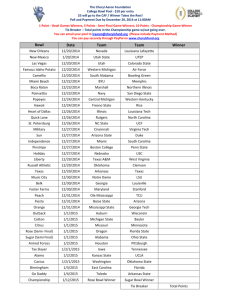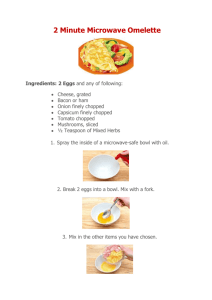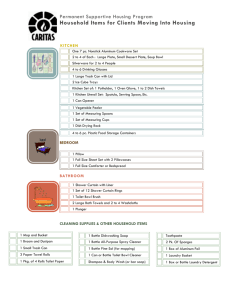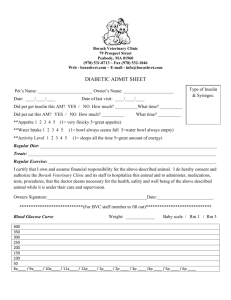RAVINGS ON TURNING BACK YARD PINE
advertisement
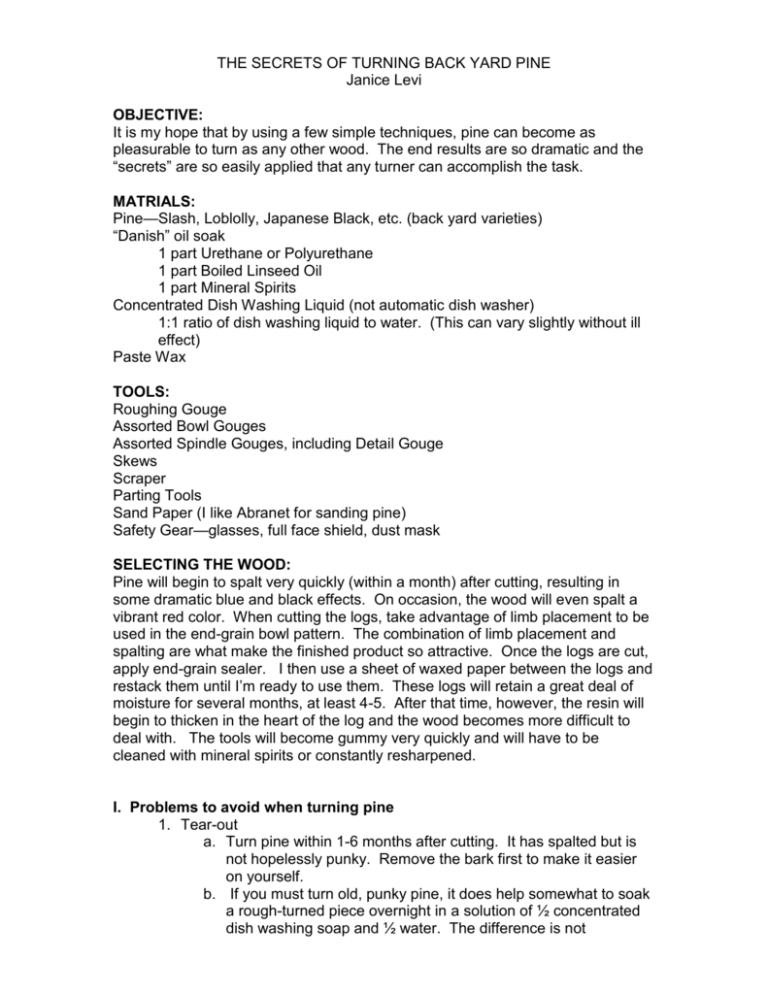
THE SECRETS OF TURNING BACK YARD PINE Janice Levi OBJECTIVE: It is my hope that by using a few simple techniques, pine can become as pleasurable to turn as any other wood. The end results are so dramatic and the “secrets” are so easily applied that any turner can accomplish the task. MATRIALS: Pine—Slash, Loblolly, Japanese Black, etc. (back yard varieties) “Danish” oil soak 1 part Urethane or Polyurethane 1 part Boiled Linseed Oil 1 part Mineral Spirits Concentrated Dish Washing Liquid (not automatic dish washer) 1:1 ratio of dish washing liquid to water. (This can vary slightly without ill effect) Paste Wax TOOLS: Roughing Gouge Assorted Bowl Gouges Assorted Spindle Gouges, including Detail Gouge Skews Scraper Parting Tools Sand Paper (I like Abranet for sanding pine) Safety Gear—glasses, full face shield, dust mask SELECTING THE WOOD: Pine will begin to spalt very quickly (within a month) after cutting, resulting in some dramatic blue and black effects. On occasion, the wood will even spalt a vibrant red color. When cutting the logs, take advantage of limb placement to be used in the end-grain bowl pattern. The combination of limb placement and spalting are what make the finished product so attractive. Once the logs are cut, apply end-grain sealer. I then use a sheet of waxed paper between the logs and restack them until I’m ready to use them. These logs will retain a great deal of moisture for several months, at least 4-5. After that time, however, the resin will begin to thicken in the heart of the log and the wood becomes more difficult to deal with. The tools will become gummy very quickly and will have to be cleaned with mineral spirits or constantly resharpened. I. Problems to avoid when turning pine 1. Tear-out a. Turn pine within 1-6 months after cutting. It has spalted but is not hopelessly punky. Remove the bark first to make it easier on yourself. b. If you must turn old, punky pine, it does help somewhat to soak a rough-turned piece overnight in a solution of ½ concentrated dish washing soap and ½ water. The difference is not miraculous, but marginally better. Let the piece dry overnight before turning or you will get an unsolicited shower. c. If the bowl blank has knots in it, soak overnight in your dish washing solution. Let dry for a day or so before proceeding with turning. 2. Warping a. Soak a rough-turned piece overnight in ½ dish washing soap and ½ water. Air dry then turn. This helps but does not completely remove the problem of warping. b. I have soaked the complete blank if it is small. 3. Chipping at the top edge a. Turn the cylinder and true up the top edge of the bowl. b. Use a skew point to define where you will begin making the interior cuts of the bowl. (These will be a tiny scratch mark) c. Mop on some of the “Danish” oil solution along the top edge of the bowl. Wipe off the excess. d. Apply thin super glue to the top edge. Don’t use any accelerator, simply be patient. e. Using the skew again, cut the desired angle for the top edge of the bowl. f. Use the skew point again to lightly define the wall thickness of the bowl. (Another tiny scratch mark) g. Then use a beading tool or bedan to actually make the cut about 3/8 to ½ inch into the interior. (Caution: Don’t go too far into the interior at this time as you may want to alter the shape of the bowl and can still do so if this interior cut is still quite shallow.) h. Now begin carefully shaping the outside of the bowl, leaving plenty of extra wood at the headstock end to support the hollowing process. i. You’ve already hollowed down about ½ inch of the interior. Begin removing wood in the same way that you would any bowl. (I use a combination of bowl gouges, spindle gouges and scrapers. At the bottom of the bowl, I lay the scraper flat, but usually tilt it to a 45 degree angle as I move the scraper toward the exterior of the bowl. If the bowl blank is too dry and punky, the scraper is not your friend.) 4. Cracking a. Once you begin hollowing the interior, the pine will begin drying quickly and cracking. To avoid cracking, keep a spray bottle of water at hand and keep it wet, wet, wet. (I spray the outside liberally and the inside where I’ve already turned. Putting a dash of dish washing soap into the spray bottle seems to work well, too.) II. Completing the Turning a. (Note: The older the pine, the thicker the resin and the gummier your tools will become. You must keep your tools very sharp as you will be cutting uphill on the inside of the bowl. If there is moisture in the wood, you actually can use your bowl gouge, your detail gouge and your scraper tilted on a 45 degree angle quite successfully. b. Once the inside is hollowed, complete the exterior base of the bowl. You may get by with some initial sanding. While sanding the outside, spray the inside with water and vice versa. Start with 100120 grit on punky wood and 120 grit on wet pine. Don’t bother to go above 220 as the real sanding happens during the Danish oil soaking process. c. Part off the bowl, remove the nub from the bottom, ignore any cracks that may have developed and immediately start the Danish oil baptizing process. III. Creating a translucent turning a. For small pieces, you can completely dunk the turning in oil—1/3 linseed, 1/3 polyurethane and 1/3 mineral spirits. I have a little bucket that I use. I like to leave the turning in the oil for an hour or overnight for the first 2-3 dunkings. After that, just a brief dunking of a minute or so is all that is necessary. No harm happens if you leave it for longer. b. For large pieces you can mop on a generous coat of oil, top and bottom, inside and outside. I generally do this by holding the turning over a bucket and literally pouring oil over it, but using a cheap paint brush works equally well. c. Set the piece on some plastic covered with paper towels and allow it to dry overnight. Or, if you have a rack that you can put over your bucket, that will work, too. d. When the piece is dry (usually within 24 hours), begin the sanding process. I start with 120 grit and I put the sanding disc on my drill press for the first 2-3 “oil/dry/sand” repetitions. That way I can hold the turning while supporting the underside of the bowl while sanding it. When it’s less than 1/8 inch thick, it really flexes and needs the support. Don’t try to do all the sanding the first go-round with the oil/drying process. e. Now put it back in the Danish oil for an hour or up to overnight. Or apply a generous mopping. Beginning with the third or fourth oiling, remove the excess oil with a paper towel, then dry overnight. Sand. You will gradually work your way to 220 or even 320 grit sand paper after about three weeks. f. After about three weeks, switch to 0000 steel wool and begin wet sanding with the oil and steel wool. If you still have cracks that have not closed up, you can now apply thin super glue, sand the area so that the sandings begin filling in the crack inside and out. You may have to glue and sand several times to get the crack filled and smooth. Do not use accelerator. g. After about three weeks, you may find it necessary to use CA glue to fill hopelessly punky areas. Use the same sanding and gluing process in “f” above. (I have not yet done so, but I plan to experiment on a small piece. I plan to cover the entire piece with thin CA glue after about three weeks to see if that will create a really smooth surface.) h. Near the end of the oiling process, the oil will build up on the areas that are completely saturated even though the entire piece may not be ready to stop oiling. Carefully wiping away the excess oil will help. Use your steel wool saturated in oil thinned a bit with mineral spirits to remove any excess dried oil so that the finished product features the feel of wood and not the feel of dried oil. i. The whole process will take about six weeks. Finally, the day will arrive when the bowl is completely soaked and all the cells have been replaced with oil. You will know it when you see it. Let the bowl dry completely (4-5 days), remove any excess oil with 0000 steel wool, then apply a very light coat of oil, thinned somewhat with mineral spirits, with a soft cloth or paper towel. Wipe away all the excess and allow to dry for another day or two. j. Finally, apply a soft wax of your choice and buff with a buffing wheel. (No poly wipe-on, no shellac, no lacquer. The oil and soft wax do it all.) I have learned almost all of this by trial and error. I did look up Ron Kent’s article on turning Norfolk Island pine (which is much denser than slash pine) and what I learned from him is the process of mopping/dunking the piece then letting it dry. Prior to that I had just been leaving the piece in the oil for a week or so, but when I took it out, it was no better than if I had only left it in for an hour. The drying between dunkings is the key. I also learned to use dish washing detergent, although my success rate with it is only marginal. RESOURCES: 1. RonKent.com—Ron first developed the method of soaking Norfolk island pine in urethane to create translucence. Ron is also an advocate of using concentrated dish washing liquid to condition the wood. 2. Janice Levi is a member of Brazos Valley Woodturners and Gulf Coast Woodturners Association. She can be reached at: a. jlevi@wellsits.net b. 254-729-2542 Revised 8/26/09


